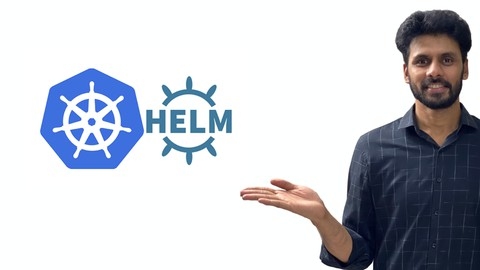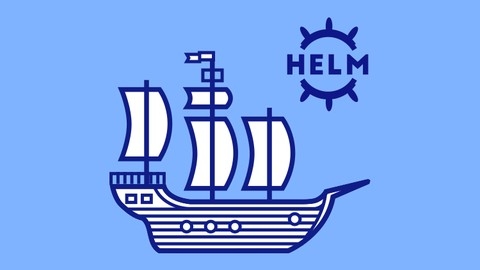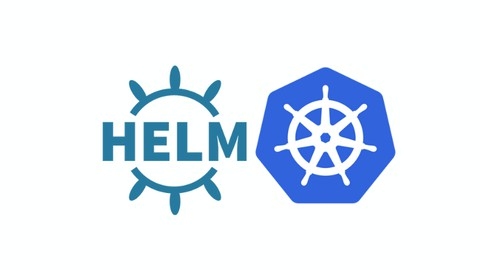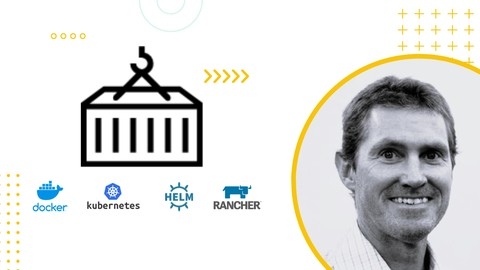Helm is a powerful package manager for Kubernetes, designed to simplify the deployment and management of applications on this container orchestration platform.
It allows you to package and configure your applications as charts, making deployments consistent, repeatable, and manageable.
Learning Helm can empower you to build and manage complex Kubernetes applications efficiently, making you a valuable asset in any development team.
Finding the right Helm course on Udemy can be tricky.
You want a course that balances theory with practical application, provides hands-on experience, and is taught by experienced professionals.
For the best Helm course overall on Udemy, we highly recommend Helm Kubernetes Packaging Manager for Developers and DevOps.
This comprehensive course covers everything from the fundamentals of Helm to advanced concepts like custom charts and secure repositories.
The instructor, a seasoned expert in Kubernetes and Helm, guides you through practical exercises and real-world scenarios, allowing you to apply your knowledge immediately.
This is our top pick, but there are other excellent Helm courses available on Udemy.
Keep reading to discover options tailored to different learning levels and interests, and find the perfect course to take your Helm skills to the next level.
Helm Kubernetes Packaging Manager for Developers and DevOps
This comprehensive course equips you with the skills to confidently manage your Kubernetes applications using Helm, a powerful tool for packaging and deploying them.
You’ll start with the fundamentals, understanding what Helm is, its key concepts like charts and repositories, and how to install and work with them.
The course progressively guides you through practical exercises, letting you install, upgrade, and uninstall applications using Helm.
You’ll learn how to build your own charts and even create complex applications by establishing dependencies between them.
The course goes beyond the basics, delving into advanced topics like crafting custom templates, testing your charts, and securing your repositories with PGP keys.
You’ll explore various types of repositories, from local to remote, and learn how to manage them effectively.
This course also introduces you to Helm plugins, providing a way to enhance Helm’s functionality.
You’ll even get a glimpse of Helm’s latest OCI repository support, expanding your understanding of this versatile tool.
With a strong focus on hands-on learning, this course provides the necessary tools and knowledge to manage your Kubernetes applications throughout their development and deployment lifecycle, ensuring you can utilize Helm effectively.
HELM - Package Manager for Kubernetes Complete Master Course
You’ll begin by understanding Helm’s fundamental purpose and its components, including the key differences between versions 2 and 3.
You’ll then learn how to install Helm, manage repositories, and create your first Helm chart.
The course introduces you to Minikube, a popular tool for setting up a local Kubernetes environment, enabling hands-on practice.
You’ll craft charts using templates to define your application configurations and deploy them to your local Kubernetes cluster.
You’ll also discover how to use Chartmuseum to host your Helm charts and manage their versions effectively.
Moving beyond the basics, you’ll delve into the intricacies of Helm charts.
You’ll explore creating charts using sub-charts, mastering template functions like include, range, and if-else for dynamic deployments, and utilizing advanced features like scope for complex deployments.
The course covers thorough testing of your Helm charts for errors using Helm Lint and emphasizes the importance of ensuring the integrity of your deployments.
To complement your Helm expertise, the course provides a solid introduction to Kubernetes, covering key concepts like YAML, pods, deployments, services, replica sets, secrets, and namespaces.
You’ll gain a strong foundation for creating and managing these resources within Kubernetes clusters.
You’ll even learn about the different types of Kubernetes clusters and how to install Minikube on both Windows and CentOS systems, giving you practical experience in setting up your development environment.
Kubernetes with HELM: Kubernetes for Absolute Beginners
This Kubernetes course is a well-structured journey into the world of container orchestration.
You’ll dive right in, learning the fundamentals of Kubernetes architecture and building your own cluster.
You’ll become proficient with essential tools like Kubectl, which you’ll use to master deployments, networking, and storage concepts.
The course then introduces you to Helm, a powerful tool for packaging and deploying applications on Kubernetes.
You’ll learn to create and manage Helm charts, streamlining your application deployment process.
The curriculum delves into advanced topics like serverless functions using Kubeless and microservices with Istio, equipping you to build scalable and resilient applications.
Throughout the course, you’ll utilize platforms like Digital Ocean and GCP to create and manage your Kubernetes environments, gaining real-world experience with these popular cloud providers.
This course provides a comprehensive foundation in Kubernetes, blending theory and practical application.
DevOps Project 2024- CI/CD with Jenkins helm on AKS & EKS
This course offers a comprehensive exploration of CI/CD best practices, utilizing the powerful trio of Jenkins, Helm, and Kubernetes.
You’ll delve into the world of both AWS (EKS) and Azure (AKS) platforms, learning to seamlessly integrate Jenkins into each environment.
Beyond the theoretical, you’ll gain practical experience in building a Springboot application and packaging it with Docker.
The course emphasizes the use of Helm charts for streamlined deployment on Kubernetes clusters, a technique that significantly simplifies complex deployments.
You’ll also become proficient in configuring Jenkins declarative pipelines for Continuous Integration (CI) jobs, streamlining the development process.
The course goes beyond the basics, guiding you through the setup and configuration of Docker and Maven plugins within your Jenkins server.
You’ll learn to leverage the power of Helm charts to manage and deploy your applications efficiently.
Additionally, the course addresses the importance of application monitoring and troubleshooting by introducing the Elasticsearch, Fluentd, and Kibana (EFK) stack.
You’ll gain hands-on experience in configuring EFK to collect and analyze logs from both your applications and the Kubernetes environment.
This comprehensive knowledge base makes you a highly valuable asset to any development team seeking to implement robust CI/CD practices.
Helm 3 - Package Manager For Kubernetes
This course dives deep into the world of Helm 3, providing you with a comprehensive understanding of this powerful Kubernetes application management tool.
You’ll start with the essentials, setting up your environment and mastering the core concepts of Helm.
Then, you’ll embark on a journey into charts, the building blocks of Helm packages, learning how to create and customize them to meet your specific needs.
The course delves into advanced techniques like working with multiple Values.yaml files for different environments, ensuring your applications deploy flawlessly across various deployments.
You’ll also explore the power of conditional statements with if, else, and elseif to create dynamic and adaptable Helm templates.
Debugging is an essential part of any development process, and this course equips you with the knowledge to troubleshoot any errors you encounter while working with Helm.
You’ll become comfortable using the Chart Museum, a repository of pre-built Helm charts, to streamline your deployments and leverage community-driven resources.
The course doesn’t just offer theory; it provides hands-on experience through practical examples like deploying Grafana, a popular open-source monitoring and analytics platform.
This real-world application will solidify your understanding of HELM and prepare you for deploying your own applications with confidence.
Helm Masterclass: 50 Practical Demos for Kubernetes DevOps
Right from the start, you’ll be immersed in setting up your learning environment, getting hands-on with essential tools like Docker Desktop and the Helm CLI.
These are the foundations upon which you’ll build your knowledge, mastering the art of creating, packaging, and deploying Helm charts.
The course takes you through a structured journey, covering a wide range of Helm commands, from the fundamental install, upgrade, uninstall, and rollback to advanced techniques like utilizing Helm hooks to control deployment lifecycles and ensuring security by learning to sign and verify charts.
As you progress, you’ll delve into the complexities of dependency management, exploring subcharts, aliases, conditions, and tags.
You’ll also get comfortable with Helm starter charts, providing you with a solid structure for developing your own custom charts.
What truly sets this course apart is the inclusion of 50 practical demos.
This hands-on approach allows you to solidify your understanding by applying what you learn in real-world scenarios.
The course doesn’t shy away from advanced concepts like using OCI Registry to store your Helm charts and validating your values.yaml file with JSON Schema.
This ensures your charts are consistent and error-free, a critical aspect of robust application management.
If you’re looking to become a master of Helm and gain the confidence to deploy applications effectively on Kubernetes, this “Helm Masterclass” course is a valuable resource.
Helm - The Kubernetes Package Manager hands-on course
You’ll start by mastering the basics, learning to install Helm and explore its features.
You’ll delve into the world of Helm charts, discovering how to add repositories, install charts, customize installations, and manage upgrades and deletions.
The course takes a hands-on approach, empowering you to test your Helm releases using “dry-run” and inspect them with the “helm get” command.
You’ll master the art of managing release history and rolling back to previous versions.
Creating your own Helm charts is a key focus.
You’ll learn to create effective “Chart.yaml” files and craft robust Helm templates, mastering the use of functions like “toYaml”, “indent”, and “nindent”.
The course emphasizes the “.Files” template method for working with ConfigMaps and Secrets, and you’ll gain proficiency in using conditional statements and looping functions.
Beyond the basics, you’ll explore Helm dependencies, including library charts, and discover how to create your own Helm repositories.
The course even delves into extending Helm by creating your own plugins, showcasing hosting options like Chartmusem and AWS S3.
Finally, the course bridges the gap to production environments, guiding you through Helm Blue/Green deployments.
You’ll learn how to provision your applications to EKS clusters using Helm and explore CI/CD techniques on GitLab and EKS.
This includes setting up CI/CD users, deploying EKS with “eksctl”, and preparing GitLab CI/CD pipelines.
Helm Masterclass
You’ll start with the fundamentals, setting up your development environment with Minikube and VS Code, and then dive into the core concepts of creating and deploying charts.
The course does an excellent job of breaking down Helm’s core functionalities.
You’ll learn how to customize charts using values files and troubleshoot common issues that arise.
The curriculum then progresses to advanced techniques like dynamic chart creation using templates and managing dependencies, equipping you with the skills to build and maintain sophisticated Kubernetes applications.
One of the standout features is the inclusion of tools like Chart Museum, which empowers you to create and share your own charts.
This is incredibly valuable for collaboration and managing a growing library of Kubernetes applications.
The course culminates with a deep dive into advanced Helm concepts such as umbrella charts and versioning.
If you’re seeking a comprehensive and practical approach to mastering Helm and streamlining your Kubernetes workflow, this course is an excellent investment.
Deploy and Run Apps with Docker, Kubernetes, Helm, Rancher
This course provides a comprehensive and hands-on introduction to the world of containerization and orchestration, equipping you with the skills to confidently deploy and manage applications using industry-standard tools.
You’ll start with the fundamentals of Docker, learning how to install it across different operating systems, build and run containers, and manage them effectively.
You’ll gain practical experience by creating Dockerfiles and building images, solidifying your understanding of this core technology.
The course then introduces you to Docker Compose, a valuable tool for orchestrating multiple containers together, enabling you to build and manage complex applications with ease.
Next, you’ll dive into the powerful world of Kubernetes, a leading container orchestration platform.
You’ll explore key concepts like Pods, Deployments, Services, and Ingress, gaining a thorough understanding of how Kubernetes manages and scales applications.
You’ll put these concepts into practice by deploying a sample Todo application on a local Kubernetes cluster, configuring it using Kubernetes YAML files, and experiencing the power of Kubernetes firsthand.
The course goes beyond the basics by introducing you to Helm, a package manager specifically designed for Kubernetes.
This section will help you understand how to create and manage charts, simplifying the process of deploying and managing your applications on Kubernetes.
You’ll learn how to publish your charts to a repository and automate deployments using a CI/CD pipeline with Travis CI, equipping you with the skills to streamline your application lifecycle.
Finally, the course explores the deployment of your applications to cloud platforms, including AWS and GCP, using Kubernetes.
You’ll learn how to create and manage Kubernetes clusters in these environments using tools like kops and eksctl, gaining valuable experience with these popular cloud platforms.
You’ll also learn to use Rancher, a powerful tool for managing Kubernetes clusters across different cloud providers, enhancing your ability to manage complex deployments efficiently.
By completing this course, you’ll have a solid grasp of the entire application lifecycle, from development and containerization to deployment and management on both local and cloud environments.
You’ll be proficient in using Docker, Kubernetes, Helm, and Rancher, enabling you to confidently build, deploy, and run your applications with efficiency and expertise.
This comprehensive knowledge will equip you for a variety of roles in the rapidly growing field of containerized applications, opening doors to exciting career opportunities.
Practical Helm Charts For Beginners
You’ll begin by understanding the challenges of managing Kubernetes applications and how Helm addresses them.
The course dives deep into the anatomy of a Helm chart, explaining its various components and how you can utilize Go templates for dynamic configuration.
You’ll also learn the intricacies of managing chart values and overriding them at runtime.
The course then guides you through the essential Helm CLI commands, such as helm install, helm upgrade, and helm rollback, providing hands-on experience to solidify your understanding.
One of the course’s highlights is its emphasis on practical application.
You’ll engage in numerous labs and exercises designed to reinforce your learning.
For example, you’ll create unit tests for your Helm charts to ensure their functionality and learn how to adapt the helm create command for custom chart structures.
As you progress, you’ll explore advanced topics like working with lists and dictionaries within Helm templates, understanding built-in objects like the release and chart objects, and creating custom resource definitions.
The course also covers named templates for reusable components and how to work effectively with remote chart repositories.
This course provides a well-structured path to mastering Helm, equipping you with the knowledge and practical skills needed to build and manage robust Kubernetes applications.










